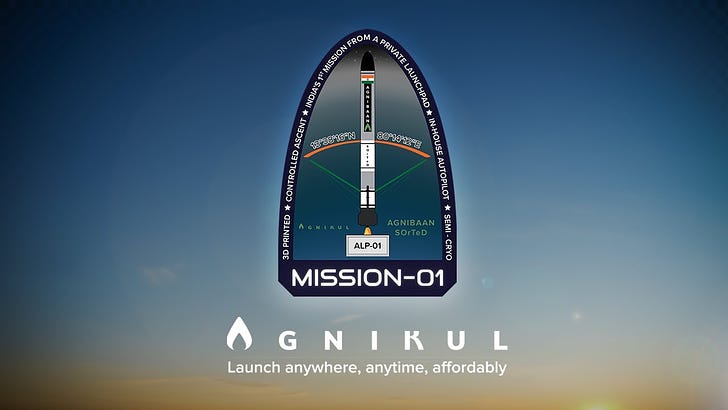Pradeep's Space Newsletter #59
Agnibaan SoRTeD, my comment on the new space policy guidelines, and other space-related news from the past week.
May 28-29
X user SolidBoosters used the Right to Information (RTI) Act to obtain information about the utilization of EOS-06/Oceansat-3. He found information about how many fishermen, who are end users of this data related to Potential Fishing Zones (PFZs) were trained. He found information about how many alerts were issued, the channels used to issue them, and the breakdown of the fishermen in the various Indian states who used the data. For more details, read this X thread.
India’s space sector regulator and promoter had conducted a national-level CANSAT competition. One of the competitors, IIT Jodhpur’s member shared the video captured by the CANSAT through its return to the ground. Hat tip: Radha Krishna Kavuluru. I share his joy at seeing such a video from the competition.
May 30
The day began with an announcement of the success of the launch of Agnikul Cosmos’s SoRTeD-01 mission from ISRO. After many congratulations and calls for videos of the launch, the company released a brief note and a photograph of the launch. A video was released much later.
The launch is the first launch of a semi-cryogenic engine from Indian soil. It was a sub-orbital flight. There was a discussion where it seemed that the heatwave led to reduced LOX loading. This, in turn, led to an earlier burnout. It looks like the mission was a success nevertheless.
There were four launch attempts before this successful launch. While aborts are good, there was frustration in some quarters and a lack of patience.
ISRO released a note highlighting the support they provided for this mission.
May 31
X user SolidBoosters also used the Right to Information (RTI) Act to reveal the turnaround time for the First Launch Pad (FLP) and Second Launch Pad (SLP) after the launch of PSLV, SSLV, GSLV and LVM3.
ISRO’s Vikram Sarabhai Space Center (VSSC) developed a Computational Fluid Dynamics package called PraVaHa. I found an X user cvkrishnan who was answering many questions related to the importance of creating this package that I found insightful.
Got to read Jatan’s Indian Space Progress #16. It has a really deep dive into Agnibaan’s launch and the road ahead. There is also a nice write-up about the Request for Qualification from NSIL for productionalisation of LVM3.
June 1
There had been many media stories about the hype of six planets lining up. The Indian Institute of Astrophysics released a series of slides debunking the hype and sharing what one could reasonably expect when one looks up at the night sky.
June 3
X user Astro_Neel shared a paper that gives us a closer look at ISRO’s Martian Boundary Layer Experiment (MarBLE).
June 5
Times of India’s journalist Chethan Kumar shared two stories.
One was on the launch of Hindustan Aeronautics Ltd (HAL) facilities for propellant tank production and CNC machining facilities. He further reports that this allows HAL to increase the production from 2 currently to 6 in the future.
The second was updates on the TRISHNA satellite. This joint project with the French space agency, CNES. There is still no timeline for the launch. The satellite is focused on studying water and energy budgets on the Earth’s surface.
Policy
India’s private sector regulator and promoter, INSPACe released guidelines and implementation of the Space Policy 2023. Ashwin Prasad from The Takshashila Institution wrote an op-ed of the same for the Deccan Herald.
This has an impact because it is believed that the number of startups has grown from 1 in 2012 to 200 in 2024. These are the companies that INSPACe regulates.
ISRO had undertaken an exercise spread through the end of 2020 and early 2021 to accept public comments on various guidelines. I had submitted comments on behalf of the Takshashila Institution at the time. INSPACe seems to have forgotten this exercise and done a private consultation of their own to release these guidelines. I hope they return to the path of public consultations.
If INSPACe had looked at those guidelines they may not have missed the ones that Ashwin has pointed out in the piece. He also missed that INSPACe missed addressing human spaceflight that looked promising for space tourism.
The Space Activities Bill still not being in Parliament is a mystery.
I had earlier written supporting INSPACe regulating ISRO and NSIL. I think this is not happening because it requires a lot of shuffling within a government organization that could be messy. NSIL is presently taking over operational responsibilities for ISRO’s remote and communication satellites. INSPACe is still building the capability to regulate the sector. There is still heavy reliance on ISRO.
This makes it necessary to look at other examples for the regulator model to follow. The Atomic Energy Regulatory Board (AERB) may provide a reasonable model to follow. The examples of SEBI and TRAI that Ashwin suggests in the piece may not make sense in the space sector.


I loved this why did I not know of this earlier!